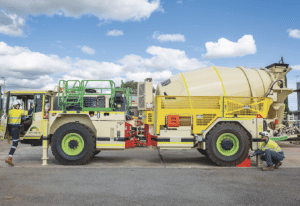DYNA Engineering’s HDPE conveyor guards have more than proved their worth in the Australian resources sector.
The benefits of high-density polyethylene (HDPE) for protective guarding on conveyor belts have been made very clear in recent years.
This is especially true when it comes to mine sites, mineral processing plants and bulk handing terminals, where damage and accidents around conveyors can easily result in unplanned downtime, not to mention worker injuries.
DYNA Engineering general manager Thomas Greaves said HDPE benefits include increased safety, recyclability, and environmental, maintenance and cost savings.
“HDPE guards are roughly 40 per cent lighter than steel equivalents,” Greaves told Australian Mining.
“If you’re talking a conveyor guard that’s a couple of hundred metres long, it can cause injuries over time. HDPE guards reduce stress and the chance of a repetitive lifting injury, as well as the labour required on and off the guards.”
According to Greaves, standard steel guards can more be easily scratched and chipped, causing corrosion. When DYNA came across HDPE as an alternative to traditional steel guards, it developed a range of robust HDPE guards that are easy to install and are resistant to caustic soda, hydrochloric acid, kerosene and sulfuric acid.

Image: DYNA Engineering
Supported by its patented ‘X’ shape design, the strength of DYNA’s HDPE guards is 60 per cent higher than standard HDPE square mesh guards.
“We developed a type of mesh that was more triangular and didn’t have large flat surfaces,” Greaves said. “This helps direct the flow of water, increasing the effectiveness of the spray when washing and hosing.
“We can customise our HDPE guards to any size and shape without increasing costs, instead of companies having their own metal and welding guide, which is slow, labour-intensive and extensive.”
Several Tier 1 miners utilising DYNA’s HDPE guards have raved about the money they have saved in relation to maintenance and replacing traditional steel guards.
“We would always hear the story about the guy with a little paint brush who, at the end of every job, would go around and hand-paint all the chips, scratches and cracks,” Greaves said.
“It would cost companies up to $200,000 to have people go around and fix all the damage from general installation. That’s now completely removed from the process because HDPE is corrosion-resistant and made in colour.
“You can scratch, chip or hit them with a hammer; it won’t cause damage like it would on a steel guard.”
DYNA’s HDPE guards can be applied to equipment beyond conveyors. To illustrate, ground support specialist Jetcrete queried about the possibility of fitting protective guarding to underground agitator trucks.
“Initially, these guards were fabricated from steel and fitted to agitator trucks for underground operation,” Jetcrete plant asset manager Andrew Purchase said. “This took place in 2020 at the Granny Smith mine in WA.
“We had an instance where part of the steel guard mesh surrounding the agitator started to foul with the rotating bowl. Being underground and in tight spaces, guards were often damaged and bent. This caused the agitator to contact the mesh guard.
“Because it was made of steel, some of it started to come adrift from the rest of the mesh. This meant the contact caused more damage with every revolution of the bowl. The steel was too strong and non-flexible, so it harmed more than it helped.”
After hearing the benefits of HDPE conveyor guards, Purchase approached DYNA for initial discussions about the design, fabrication, fitting and trialling of HDPE guards.
Several of Jetcrete’s sites have now completed comprehensive trials and the company has commissioned DYNA to continue fabricating the guards to its fleet.
“We’re so pleased that this new use for HDPE guarding in underground equipment has come through with flying colours,” Greaves said.
“That we design, manufacture and fabricate all this in-house here at our own workshop in Bayswater, Perth, is very encouraging. And it proves you don’t have to be a multinational to make a new mining refinement work and find a market for it.”
This feature appeared in the October 2024 issue of Australian Mining.



